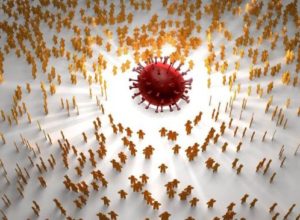
The Covid-19 cases in the country have been rising exponentially with each passing day. As the Omicron variant starts its rampage, headlines have been screaming about the R0 (R-naught) value being higher now than it was at the peak of the second wave that devastated the country.
According to the Indian Council of Medical Research Director-General Dr Balram Bhargava, Omicron is the predominant circulating strain in the spiking Covid cases. As per data, the R0 stood at 2.69 – higher than the value of 1.69 that was recorded during the peak of the pandemic’s second wave in April-May last year.
So, what is this R0 value? Is it something you should be worried about it, or is it yet another jargon in the information overload that we have been battling since the onset of the pandemic, along with it?
R0 is the rate at which a virus spreads or is transmitted from one person to another. It is a mathematical representation of how contagious an infectious disease is. It is also called the reproduction number – when the virus is transmitted, it reproduces itself. It is calculated by the epidemiologists by a simple equation: R0 = new cases of the infection over a said period/ existing cases of the infection. According to a BBC report, an infection’s R number has to be determined considering a number of factors, including the rate of deaths, hospitalisation and positive results from tests.
What is R0’s significance in policymaking?
The number tells the health policymakers about the average number of people who will contract a contagious infection like Covid-19 and how many healthy people can one infected person affect. This is pertinent when the infection, or a variant of the virus as in the case of Omicron, has not affected a population yet. Simply put, this is applicable to the population that was previously free of infection and have not been vaccinated, and thereby do not have immunity for the disease in question. Policymakers consider it to be an early warning signal that can suggest what trajectory the infection can take. Even minor variations can hold major significance – even a change of 0.1 in the values can translate to major numbers in terms of active cases.
While the numbers are scary, they cannot be taken in isolation. Despite Omicron being a new variant, the fact of the matter is that India has achieved major milestones in its Covid vaccination drive. Nearly 90 per cent of India’s eligible population has received one shot and over 63 per cent of the population has received both doses, as per government data. With Indian teens also being vaccinated, and the “precautionary” third dose set to begin for the frontline healthcare workers and senior citizens with comorbidities, most of the population has some level of resistance against the virus.
As prior immunity in a population plays role in determining the R factor, India’s number need not cause the alarm that was there ahead of the second wave. However, that does not mean the infection can be taken lightly.




 Driving Naari Programme launched in Chandigarh
Driving Naari Programme launched in Chandigarh






























